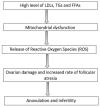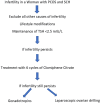Influence of Subclinical Hypothyroidism on Women With Polycystic Ovary Syndrome: A Literature Review
- PMID: 36176844
- PMCID: PMC9511984
- DOI: 10.7759/cureus.28468
Influence of Subclinical Hypothyroidism on Women With Polycystic Ovary Syndrome: A Literature Review
Abstract
Subclinical hypothyroidism (SCH) is a commonly encountered condition in women with polycystic ovary syndrome (PCOS). Nevertheless, it is unclear whether SCH has any potential impact on the metabolic and reproductive profiles of women with PCOS. Hence, this literature review explores and establishes the link between these two conditions. In women with PCOS, SCH was found to aggravate insulin resistance and dyslipidemia. It was also linked to hormonal imbalances leading to higher infertility rates among the PCOS-SCH group. Therefore, women with PCOS must be screened for thyroid function frequently and managed accordingly.
Keywords: dyslipidemia; female infertility; homeostatic model assessment of insulin resistance (homa-ir); polycystic ovary syndrome (pcos); subclinical hypothyroidism.
Copyright © 2022, Peddemul et al.
Conflict of interest statement
The authors have declared that no competing interests exist.
Figures




References
-
- The prevalence of polycystic ovary syndrome in a community sample assessed under contrasting diagnostic criteria. March WA, Moore VM, Willson KJ, Phillips DI, Norman RJ, Davies MJ. Hum Reprod. 2010;25:544–551. - PubMed
-
- Assessment and management of polycystic ovary syndrome: summary of an evidence-based guideline. Teede HJ, Misso ML, Deeks AA, et al. Med J Aust. 2011;195:0–112. - PubMed
-
- Obesity and cancer: evidence, impact, and future directions. Colditz GA, Peterson LL. Clin Chem. 2018;64:154–162. - PubMed
-
- Consensus on women's health aspects of polycystic ovary syndrome (PCOS): the Amsterdam ESHRE/ASRM-Sponsored 3rd PCOS Consensus Workshop Group. Fauser BC, Tarlatzis BC, Rebar RW, et al. Fertil Steril. 2012;97:28–38. - PubMed
Publication types
LinkOut - more resources
Full Text Sources
Miscellaneous
